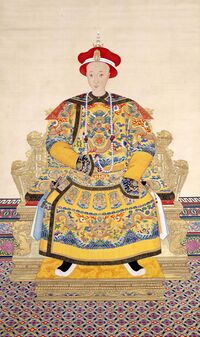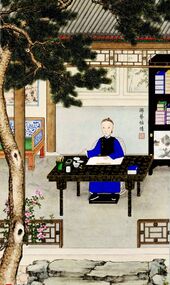الإمبراطور تونگژي Tongzhi Emperor
| الإمبراطور تونگژي 同治帝 Tongzhi Emperor | |||||||||||||||||
|---|---|---|---|---|---|---|---|---|---|---|---|---|---|---|---|---|---|
| Huangdi 皇帝 | |||||||||||||||||
 | |||||||||||||||||
| Emperor of the Qing dynasty | |||||||||||||||||
| العهد | 11 November 1861 – 12 January 1875 | ||||||||||||||||
| سبقه | Xianfeng Emperor | ||||||||||||||||
| تبعه | Guangxu Emperor | ||||||||||||||||
| Regents | Zaiyuan (1861) Duanhua (1861) Sushun (1861) Empress Dowager Ci'an (1861–1881) Empress Dowager Cixi (1861–1908) | ||||||||||||||||
| وُلِد | Aisin Gioro Zaichun (愛新覺羅·載淳) 27 أبريل 1856 (咸豐六年 三月 二十三日) Chuxiu Palace, المدينة المحرمة | ||||||||||||||||
| توفي | 12 يناير 1875 (aged 18) (同治十三年 十二月 五日) Hall of Mental Cultivation | ||||||||||||||||
| الدفن | Hui Mausoleum, Eastern Qing tombs | ||||||||||||||||
| الجواري | |||||||||||||||||
| |||||||||||||||||
| البيت | آيشن-جيورو | ||||||||||||||||
| الأب | Xianfeng Emperor | ||||||||||||||||
| الأم | Empress Xiaoqinxian | ||||||||||||||||
الإمبراطور تونگژي (27 أبريل 1856 – 12 يناير 1875)، وُلِد بإسم Zaichun of the Aisin Gioro clan,[1] was the ninth Emperor of the Qing dynasty, and the eighth Qing emperor to rule over China proper. His reign, from 1861 to 1875, which effectively lasted through his adolescence, was largely overshadowed by the rule of his mother, Empress Dowager Cixi. Although he had little influence over state affairs, the events of his reign gave rise to what historians call the "Tongzhi Restoration", an unsuccessful modernization program.
السيرة
The only surviving son of the Xianfeng Emperor and Empress Dowager Cixi, the Tongzhi Emperor was namesake to the attempted political reform initiated by his mother, called the Tongzhi Restoration. His era name was originally proposed as "Qixiang" (祺祥; Manchu: Fengšengge sabingga), but this was later changed upon his succession to "Tongzhi". The era name means 'order and prosperity' coming from the Confucian teaching that "there are many ways of being a good government, and they can all be summarized as order and prosperity".[2]
The Tongzhi Emperor became emperor at the age of five upon the death of his father, the Xianfeng Emperor. His father's choice of a regent, Sushun, was removed in favor of شراكة بين والدته الإمبراطورة الأرملة تسيشي و الإمبراطورة الأرملة تسيآن.
While there had most likely been hopes that the Tongzhi Emperor would become a successful leader like the Kangxi Emperor (who ascended the throne as a child in 1661), those hopes would soon be disappointed, as the Tongzhi Emperor grew up to become an obstinate and dissolute young man who also expressed his dissatisfaction with his mother Empress Cixi.[3]
In the fall of 1872, he married Empress Xiaozheyi and two official concubines. The Tongzhi Emperor apparently had wanted to take up power immediately, prompting a quarrel at court regarding the dismantling of the regency and the timing of it. However, the two empresses dowager stuck by the intended date of February 23, 1873.[4]
The day after the Tongzhi Emperor took power, foreigners requested an audience with him. The request precipitated a sharp disagreement between the ministers at the foreign legations, who made it clear that they would not perform the ritual kowtow to the emperor, and the Zongli Yamen (foreign affairs ministry), regarding the protocol to be observed. The Qing government was also loath to hold the audience within the confines of the Forbidden City, eventually settling on the "Pavilion of Purple Light" at one of the lakeside palaces to the west of the Forbidden City, which is now part of Zhongnanhai.[5] The audience was finally held on 29 June 1873. After the audience, however, the foreign representatives made clear their annoyance at being received in a hall initially used by the Qing emperors to receive envoys of tributary states.
In the fall of 1874, the Tongzhi Emperor got into a clash with his ministers, which included his two uncles, Prince Gong and Prince Chun, largely over the emperor's plans to rebuild the Old Summer Palace at a time in which the empire was bankrupt, and over his dissolute behavior. The emperor reacted by firing the ministers, but Empresses Dowager Ci'an and Cixi intervened, and he had them reinstated. That December, it was announced that he was ill with smallpox, and the Empress Dowagers resumed the regency. He died on 12 January 1875, leaving no sons to succeed him.[بحاجة لمصدر]
The Tongzhi Emperor's death left the court in a succession crisis as he was childless. Eventually, the empresses dowager designated the Tongzhi Emperor's three-year-old cousin, Zaitian, as the heir to the throne. Zaitian was biologically Prince Chun's son, but was symbolically adopted as the Xianfeng Emperor's son to make him eligible to succeed the Tongzhi Emperor. Zaitian was thus enthroned as the Guangxu Emperor, with Empresses Dowager Ci'an and Cixi resuming their roles as regents. Empress Alute, Tongzhi's wife, died shortly after her husband. The cause of her death is unclear.[بحاجة لمصدر]
حركة تقوية الذات
| الإمبراطور تونج زي | |||||||||||
|---|---|---|---|---|---|---|---|---|---|---|---|
| الصينية | 同治帝 | ||||||||||
| |||||||||||
The inspiration for the future Self-Strengthening Movement arose from the notion that China's defense in the face of war and rebellion must come from within, as the superior man strengthens himself under imperative of Heaven's robust action. The costs of war and rebellion dictated that the Qing dynasty undertake vigorous measures to ensure its survival. Moreover, the very survival of China itself was now at stake.[بحاجة لمصدر]
Self-strengthening efforts evolved in a succession of stages over a period of almost half a century. In 1840 Imperial Commissioner Lin Zexu, impressed by the power of British warships in the initial battles of the Opium War, advocated adoption of Western naval technology. The paddle-wheel steamer Nemsis had run circles around cumbersome Chinese war junks. Some Chinese at first believed the paddle-wheels were powered by men inside the ship, but soon came to appreciate the power of steam, Commissioner Lin was the first self-strengthener.[بحاجة لمصدر]
Self-strengthening enterprises, including arsenals, shipyards, and technical schools, were now established in the principal treaty ports where access to Western technology was most direct. By 1860, the overwhelming bulk of the Chinese scholarly class had become cognizant of the enormity of changes that were taking place due to the increasingly prevalent Western presence in China. They now proclaimed that change was irresistible and advocated for deeper studies of Western technology. Many reforms were proposed and implemented such as the Self-Strengthening Movement, but ultimately the failure of reforms was due to multiple factors such as political machinations.[6][7]
العائلة
الإمبراطورة
- Empress Xiaozheyi, of the Arute clan (孝哲毅皇后 阿魯特氏; 25 July 1854 – 27 March 1875), eighth cousin once removed
皇后..嘉順皇后
الجواري النبيلات الإمبراطوريات
- Imperial Noble Consort Shushen, of the Fuca clan (淑慎皇貴妃 富察氏; 24 December 1859 – 13 April 1904)
慧妃→皇貴妃..敦宜皇貴妃 - Imperial Noble Consort Gongsu, of the Arute clan (恭肅皇貴妃 阿魯特氏; 20 September 1857 – 14 April 1921)
珣嬪→珣妃..珣貴妃→珣皇貴妃→莊和皇貴妃 - Imperial Noble Consort Xianzhe, of the Hešeri clan (獻哲皇貴妃 赫舍里氏; 2 July 1856 – 3 February 1932)
瑜嬪→瑜妃..瑜貴妃→瑜皇貴妃→敬懿皇貴妃 - Imperial Noble Consort Dunhui, of the Sirin Gioro clan (敦惠皇貴妃 西林覺羅氏; 6 September 1856 – 18 May 1933)
瑨貴人→瑨嬪..瑨妃→瑨貴妃→榮惠皇貴妃
السلف
| Qianlong Emperor (1711–1799) | |||||||||||||||||||
| Jiaqing Emperor (1760–1820) | |||||||||||||||||||
| Empress Xiaoyichun (1727–1775) | |||||||||||||||||||
| Daoguang Emperor (1782–1850) | |||||||||||||||||||
| He'erjing'e | |||||||||||||||||||
| Empress Xiaoshurui (1760–1797) | |||||||||||||||||||
| Lady Wanggiya | |||||||||||||||||||
| Xianfeng Emperor (1831–1861) | |||||||||||||||||||
| Mukedengbu (d. 1803) | |||||||||||||||||||
| Yiling | |||||||||||||||||||
| Empress Xiaoquancheng (1808–1840) | |||||||||||||||||||
| Lady Uya | |||||||||||||||||||
| Tongzhi Emperor (1856–1875) | |||||||||||||||||||
| Jilang'a | |||||||||||||||||||
| Jingrui | |||||||||||||||||||
| Lady Aisin Gioro | |||||||||||||||||||
| Huizheng (1805–1853) | |||||||||||||||||||
| Lady Gūwalgiya | |||||||||||||||||||
| Empress Xiaoqinxian (1835–1908) | |||||||||||||||||||
| Huixian | |||||||||||||||||||
| Lady Fuca | |||||||||||||||||||
انظر أيضاً
المراجع
الهامش
- ^ Hummel, Arthur W. Sr., ed. (1943). . Eminent Chinese of the Ch'ing Period. United States Government Printing Office.
- ^ (Empress Dowager Cixi, pg 51)
- ^ The Last Empress of China(Anchee Min, 2006)
- ^ Seagrave, Sterling Dragon Lady: the Life and Legend of the Last Empress of China (Knopf, 1992), pp. 130–131
- ^ Seagrave, pg. 131
- ^ Fairbank, John King (1978). The Cambridge History of China Vol. 2. Cambridge University Press. pp. 156–161. ISBN 0521220297.
- ^ Feuerwerker, Albert (1970). China's early industrialization: Sheng Hsuan-huai (1844-1916) and Mandarin enterprise Volume 1 of Harvard East Asian series. Atheneum/the University of Michigan. pp. 2–3, 315–324.
المصادر
- Zhang Caitian; Wu Changshou. . In Zhao Erxun; et al. (eds.). 《清史稿》 [Draft History of Qing] (in الصينية التقليدية).
{{cite book}}: Check|author1=value (help); Check|author2=value (help)CS1 maint: multiple names: authors list (link) CS1 maint: numeric names: authors list (link) - Sterling Seagrave, Dragon Lady ISBN 0-679-73369-8.
- Daily life in the Forbidden City, Wan Yi, Wang Shuqing, Lu Yanzhen. ISBN 0-670-81164-5.
- Forbidden City: The Great Within, Second Edition. May Holdsworth, Caroline Courtauld. ISBN 962-217-792-1.
للاستزادة
- Jung Chang, Empress Dowager Cixi: The Concubine Who Launched Modern China, (2013) ISBN 978-0-307-27160-0.
- Mary Clabaugh Wright. The Last Stand of Chinese Conservatism: The T'ung-Chih Restoration, 1862-1874. (Stanford: Stanford University Press, 1957).
- Hummel, Arthur W. Sr., ed. (1943). . Eminent Chinese of the Ch'ing Period. United States Government Printing Office.
الإمبراطور تونج زي وُلِد: 27 أبريل 1856 توفي: 12 يناير 1875
| ||
| ألقاب ملكية | ||
|---|---|---|
| سبقه شيانفنگ الإمبراطور |
إمبراطور أسرة تشينگ إمبراطور الصين 1861–1875 |
تبعه گوانگشو الإمبراطور |
- Short description is different from Wikidata
- Articles containing صينية-language text
- مقالات ذات عبارات بحاجة لمصادر
- Articles with hatnote templates targeting a nonexistent page
- Portal templates with default image
- CS1 maint: numeric names: authors list
- CS1 uses الصينية-language script (zh)
- CS1 الصينية التقليدية-language sources (zh-hant)
- مواليد 1856
- وفيات 1875
- عقد 1850 في الصين
- عقد 1860 في الصين
- عقد 1870 في الصين
- 19th-century Chinese monarchs
- 19th-century LGBT people
- رجال ذوو ميول جنسية ثنائية
- Child rulers from Asia
- وفيات بالجدري
- LGBT royalty
- أباطرة أسرة تشينگ

